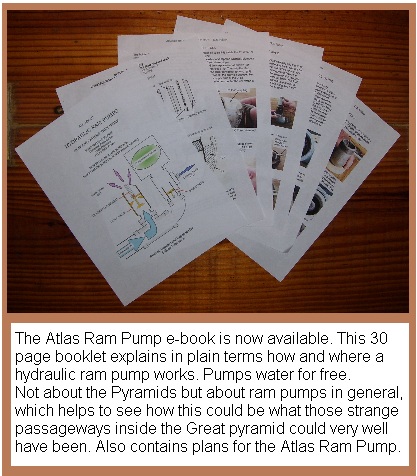 © 2013 Atlas Publications
The Great Pyramid of Giza.
© 2013 Atlas Publications
The Great Pyramid of Giza.
Into the Ascending Passage beyond the check block to the Grand Gallery
Cross sectional drawing of the inner passages and
chambers of the Pyramid as known to date.
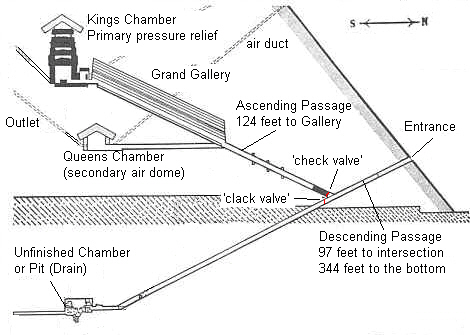
Beyond the check block and into the Ascending Passage
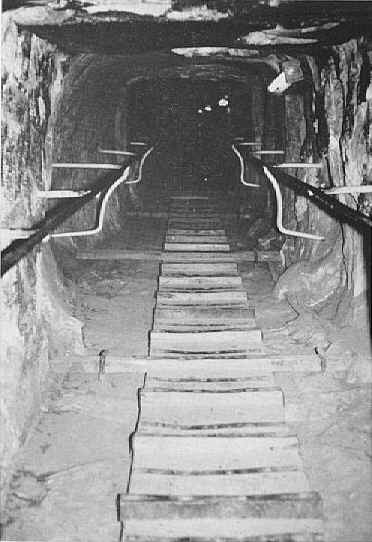 The ascending passage is also lined with smoothed limestone slabs, and has the same height and width as
the descending passage. It also inclines at the same slope of 26-degrees. This passage is part of what
we can call the 'high-pressure' side of the ram pump system. The high pressure is sealed behind the
check block, a one-way valve. This area corresponds to the high-pressure side of a conventional hydraulic
ram water pump.
The ascending passage is also lined with smoothed limestone slabs, and has the same height and width as
the descending passage. It also inclines at the same slope of 26-degrees. This passage is part of what
we can call the 'high-pressure' side of the ram pump system. The high pressure is sealed behind the
check block, a one-way valve. This area corresponds to the high-pressure side of a conventional hydraulic
ram water pump.
Following the ascending passage, after 124 feet, we finally arrive at a large open space where the...
Ascending Passage meets the Queens Chamber Passage
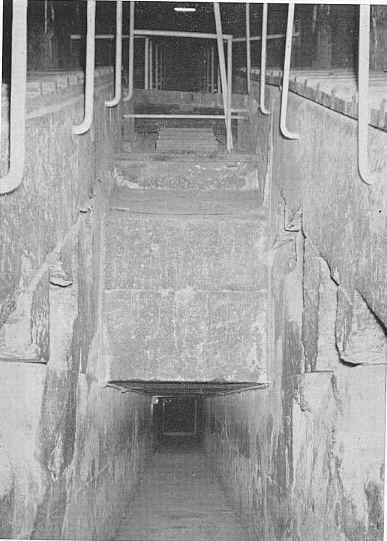 At this point of intersection, you can take one of two routes. You can continue going up to the large open area
called the Grand Gallery and continue up and eventually end up in the King’s chamber.
At this point of intersection, you can take one of two routes. You can continue going up to the large open area
called the Grand Gallery and continue up and eventually end up in the King’s chamber.
Or continue in a
horizontal direction through the lower passage (127 feet long) and wind up in the Queen’s chamber. I
t appears this horizontal passage to the 'Queen's Chamber' was where the water exited the system to the outlet.
There is also at this intersection a hole, called the 'well shaft', which leads to an open area called
the 'Grotto' and on down, eventually ending at the desceding passage. This was probably a place to dispose of
silt and debris rather than haul it out through the check block and out through the entrance. The fact that it
hits the other passage is probably the result of explorers or thieves tunneling down from the grotto in search
of treasure. Or the whole thing might be attributed to work done after the pump fell into disrepair and disuse.
Considering the level of craftmanship in the original construction, this 'Grotto' was almost surely chiseled
out later.
Queens Chamber Outlet Passage
As mentioned before, if you continue at the junction of the ascending passage and Grand Gallery through the
horizontal passage which runs for 127 feet you wind up in the Queen’s chamber. This passage is 3 feet 9
inches high and 3 feet 5 inches wide. A sudden drop of 2 feet occurs towards the end of the passage before
the entrance to the Queen's chamber, perhaps to catch silt, to be removed during cleaning operations.
The Queen's chamber has a rough floor and a gabled limestone roof. The chamber dimensions are 18 feet 10
inches by 17 feet 2 inches. It has a double pitched ceiling 20 1/2 feet at its highest point, formed by huge
blocks of limestone at a slope of about 30 degrees. This high ceiling was certainly a secondary 'air dome'.
Although coventional ram pumps don't have one of these, it might have been needed in such a large ram to
smooth the output water pressure, perhaps relieving some strain on the pipes going to where the water was
needed. During operation, this chamber most certainly had air in the upper part of it. This would absorb the
shock of incoming pulses of water. The walls of this chamber are mysteriously encrusted with salt as much as
much as 1/2 inch thick. This was probably due to centuries of river water moving through it, with periodic
times with air in the chamber as the water level rose and fell with each surge.
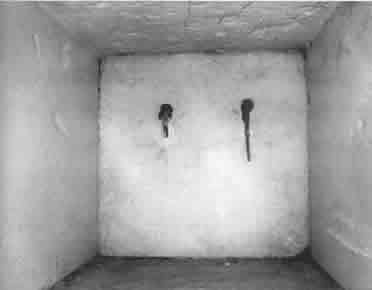 Rudolf Gantenbring in 1993 sent a small robot with a camera up the southern air shaft in the Queen's Chamber. After traveling about 200 feet up the air shaft it came to a small door complete with copper handles, or what is now commonly referred to as an ‘unidentified stone object’. The air shafts are about 9 inches square. As far as we know, this door has not been opened and what is inside remains unknown. It is here that, logically, the water was let out, and corresponds perfectly to the 'delivery outlet' in a conventional ram water pump. One or both of the 'air shafts' was surely the route to the outside, where it hooked up to the pipes carrying water to the city. This water was purified during this whole process. First, in the aqueduct, open to the sunshine, the water was irradiated by UV; sediment was settled out inside the pyramid, and the water was cooled by the constant 68 degree interior temp of the pyramid. And finally when it was sprayed into the air at the fountains in the city, that would aerate the water, as well as cool the courtyard.
Rudolf Gantenbring in 1993 sent a small robot with a camera up the southern air shaft in the Queen's Chamber. After traveling about 200 feet up the air shaft it came to a small door complete with copper handles, or what is now commonly referred to as an ‘unidentified stone object’. The air shafts are about 9 inches square. As far as we know, this door has not been opened and what is inside remains unknown. It is here that, logically, the water was let out, and corresponds perfectly to the 'delivery outlet' in a conventional ram water pump. One or both of the 'air shafts' was surely the route to the outside, where it hooked up to the pipes carrying water to the city. This water was purified during this whole process. First, in the aqueduct, open to the sunshine, the water was irradiated by UV; sediment was settled out inside the pyramid, and the water was cooled by the constant 68 degree interior temp of the pyramid. And finally when it was sprayed into the air at the fountains in the city, that would aerate the water, as well as cool the courtyard.
Intro
Descending Passage
Ascending Passage
NEXT PAGE
Pyramid Pump
This site is a collaboative effort by:
Edward Weaver , amateur Egyptologist and avid Pyramidologist. Ed has studied these ancient civilizations for many years, as well as the idea of a hydraulic structure within the Giza Pyramid. Any comments or questions in these areas are welcomed.
Don Wilson.,
author of All About Hydraulic Ram Pumps has been building, installing and consulting on ram pumps for almost 2 decades. His experiences revealed the functions of the inner chambers and passages of the Great Pyramid as a possible working Hydraulic Ram Water Pump. Any comments or questions in these areas. or on this web site, are welcomed.
Most of the photos in this site were taken from the out of print PYRAMIDOLOGY by Adam Rutherford, and SECRETS OF THE GREAT PYRAMID by Peter Tompkins; also some material from the Giza Pyramid Research site as well as other public domain sources. Much thanks and appreciation to these.
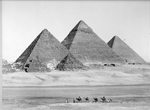
© 2013 Atlas Publications
© 2001 Edward Weaver

 © 2013 Atlas Publications
© 2013 Atlas Publications

 The ascending passage is also lined with smoothed limestone slabs, and has the same height and width as
the descending passage. It also inclines at the same slope of 26-degrees. This passage is part of what
we can call the 'high-pressure' side of the ram pump system. The high pressure is sealed behind the
check block, a one-way valve. This area corresponds to the high-pressure side of a conventional hydraulic
ram water pump.
The ascending passage is also lined with smoothed limestone slabs, and has the same height and width as
the descending passage. It also inclines at the same slope of 26-degrees. This passage is part of what
we can call the 'high-pressure' side of the ram pump system. The high pressure is sealed behind the
check block, a one-way valve. This area corresponds to the high-pressure side of a conventional hydraulic
ram water pump.  At this point of intersection, you can take one of two routes. You can continue going up to the large open area
called the Grand Gallery and continue up and eventually end up in the King’s chamber.
At this point of intersection, you can take one of two routes. You can continue going up to the large open area
called the Grand Gallery and continue up and eventually end up in the King’s chamber. Rudolf Gantenbring in 1993 sent a small robot with a camera up the southern air shaft in the Queen's Chamber. After traveling about 200 feet up the air shaft it came to a small door complete with copper handles, or what is now commonly referred to as an ‘unidentified stone object’. The air shafts are about 9 inches square. As far as we know, this door has not been opened and what is inside remains unknown. It is here that, logically, the water was let out, and corresponds perfectly to the 'delivery outlet' in a conventional ram water pump. One or both of the 'air shafts' was surely the route to the outside, where it hooked up to the pipes carrying water to the city. This water was purified during this whole process. First, in the aqueduct, open to the sunshine, the water was irradiated by UV; sediment was settled out inside the pyramid, and the water was cooled by the constant 68 degree interior temp of the pyramid. And finally when it was sprayed into the air at the fountains in the city, that would aerate the water, as well as cool the courtyard.
Rudolf Gantenbring in 1993 sent a small robot with a camera up the southern air shaft in the Queen's Chamber. After traveling about 200 feet up the air shaft it came to a small door complete with copper handles, or what is now commonly referred to as an ‘unidentified stone object’. The air shafts are about 9 inches square. As far as we know, this door has not been opened and what is inside remains unknown. It is here that, logically, the water was let out, and corresponds perfectly to the 'delivery outlet' in a conventional ram water pump. One or both of the 'air shafts' was surely the route to the outside, where it hooked up to the pipes carrying water to the city. This water was purified during this whole process. First, in the aqueduct, open to the sunshine, the water was irradiated by UV; sediment was settled out inside the pyramid, and the water was cooled by the constant 68 degree interior temp of the pyramid. And finally when it was sprayed into the air at the fountains in the city, that would aerate the water, as well as cool the courtyard.
